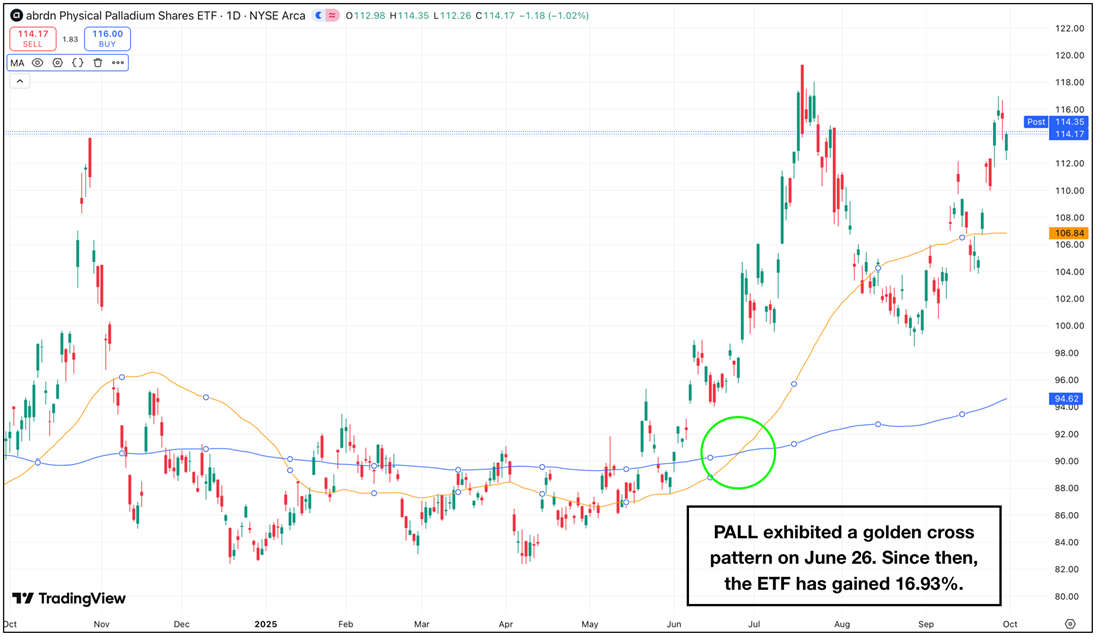Amid a backdrop of ongoing geopolitical uncertainty, a weakening U.S. dollar, ongoing market uncertainty, and creeping inflation, precious metals are having a banner year. Gold has set 11 all-time highs and has posted a year-to-date (YTD) gain of more than 45%. Silver, which often follows gold, has outperformed the yellow metal with a YTD gain of nearly 57%. Meanwhile, platinum is up 75% in 2025, trading near a 17-year high.
In September, the Federal Reserve’s first rate cut since 2024 added another tailwind for precious metal prices. The asset class historically exhibits an inverse correlation with interest rates, which could prove to be a catalyst again this month. According to the CME Group’s FedWatch Tool, there’s currently a 96.7% chance that the Fed will cut rates again at its October meeting.
abrdn Physical Palladium Shares ETF Today
PALL
abrdn Physical Palladium Shares ETF
$130.28 -1.46 (-1.11%) As of 04:10 PM Eastern
- 52-Week Range
- $82.39
▼
$148.49 - Assets Under Management
- $208.74 million
However, while gold, silver, and platinum have handily beaten the market this year, so too has another—albeit an often overshadowed—precious metal.
Palladium’s YTD gain of more than 41% has justified its role in any portfolio, but it doesn’t receive the same fanfare as those aforementioned metals.
But for investors looking to diversify their commodities exposure, keeping the metal on their radar is a good start. And one way of doing that is by tracking the abrdn Physical Palladium Shares ETF NYSEARCA: PALL, which is up more than 36% YTD and not only outperforming the broad market, but outperforming the top sectors of the S&P 500, including 2025’s index-leading communication services sector.
From Dentistry to Fuel Cells, Palladium Demand Runs the Gamut
The last time many people heard about palladium was during the height of the pandemic, when thieves across the country made headlines for stealing catalytic converters from vehicles’ exhaust systems. While that’s the foremost use of palladium, accounting for 80% of the precious metal’s demand, its applications span numerous industries.
Today, the metal can be found in surgical instruments, implant components, and fuel cells. Its conductivity and anticorrosive features make it coveted by the electronics industry, with uses in capacitors, printed circuit boards, semiconductor frames, and hard drives. Additionally, palladium’s high melting point makes it ideal for applications in aerospace, while its bright white appearance and hypoallergenic properties make it an attractive lower-cost alternative to platinum in jewelry.
That demand is holding steady in spite of the global shift towards emissions-free electric vehicles (EVs), which is slowing the need for catalytic converters. But industrial consumption—specifically from the electronics industry—is offsetting slipping demand due to EVs. As a result, palladium prices are at their highest levels since July, driven chiefly by concerns about supply constraints and a rebound in industrial demand.
Those supply constraints are what makes the precious metal particularly attractive in the near to medium term. Russia and South Africa account for around 80% of global output, which leaves the market susceptible to supply chain and geopolitical risks. That will continue to support prices, which this year have reached their highest levels since 2023.
PALL: 2025’s Market-Beating Palladium ETF
The abrdn Physical Palladium Shares ETF is—as its name suggests—backed by the physical precious metal. The Aberdeen Group, which manages the fund, holds palladium bars in a secure vault in London. The ETF is designed to offer investors a simple means of accessing the precious metals market. At $114.17 per share, it is also a cost-efficient way to invest in palladium, whose current spot price is $1,264 per troy ounce.
With $208.74 million in assets under management (AUM), PALL is a fraction of the size of popular index funds like the Vanguard S&P 500 ETF NYSEARCA: VOO and its $758.02 billion in AUM. It has far lower volume, with a three-month daily average of 316,720 shares. For context, VOO’s three-month daily average is more than seven million shares, so there are some liquidity concerns with PALL.
But PALL has outperformed the VOO in 2025, posting a YTD gain of more than 36%, while the S&P 500-tracking VOO has returned less than 14% to its shareholders. Its expense of 0.60% is relatively high for a passively managed ETF. But the PALL is truly appealing as a buy-low candidate.
That may be hard to believe for a fund that’s outperformed every stock market sector in 2025. But zooming out, PALL is down more than 59% from its all-time high on March 4, 2022. After consolidating since Jan. 2024, the fund looks like it could be in the midst of a genuine breakout.

That notion can be supported by the ETF’s one-year, which displayed a bullish golden cross on June 26 (green circle in the chart above). That pattern, which occurs when the 50-day moving average passes above the 200-day moving average, typically precedes upward price action. Since that golden cross emerged, PALL is up nearly 17%, and I wouldn’t be surprised if that trend continues throughout the remainder of the year.
Before you consider abrdn Physical Palladium Shares ETF, you'll want to hear this.
MarketBeat keeps track of Wall Street's top-rated and best performing research analysts and the stocks they recommend to their clients on a daily basis. MarketBeat has identified the five stocks that top analysts are quietly whispering to their clients to buy now before the broader market catches on... and abrdn Physical Palladium Shares ETF wasn't on the list.
While abrdn Physical Palladium Shares ETF currently has a Hold rating among analysts, top-rated analysts believe these five stocks are better buys.
View The Five Stocks Here
Wondering where to start (or end) with AI stocks? These 10 simple stocks can help investors build long-term wealth as artificial intelligence continues to grow into the future.
Get This Free Report